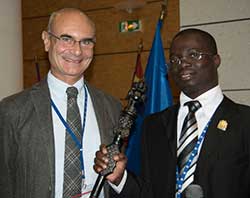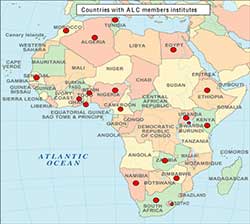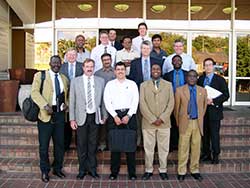A Synchrotron Light Source for Africa
Sekazi K. Mtingwa

Several of the researcher and student participants, who numbered close to a hundred. Two attendees hold traditional African ceremonial sticks. The larger stick metaphorically summoned the participants and “allowed” the opening of the Conference and Workshop. During the sessions, each speaker held up the smaller stick, which gave the authority to speak.
After many discussions both within Africa and globally over the past fifteen years, momentum is growing for an African advanced light source. The formal movement started with the election of an international Interim Steering Committee for the African Light Source (ISC-AfLS). Organizers announced the newly elected members in August 2014 at the biennial African School on Fundamental Physics and its Applications, held at the University of Cheikh Anta Diop in Dakar, Senegal. ISC members, chaired by Simon Connell who was then at the University of Johannesburg, represented a geographically diverse set of countries, including Egypt, Ethiopia, France, Japan, Nigeria, Rwanda, Senegal, South Africa, Sweden, United States, and Zimbabwe. The role of the ISC-AfLS was to initiate a transparent, inclusive and democratic process, culminating in the First African Light Source Conference and Workshop that convened at the European Synchrotron Radiation Facility (ESRF) in Grenoble, France during November 2015.
Although organizers will convene most future meetings in Africa, for the first such gathering, the ISC chose the ESRF venue so that participants, such as students and policymakers not familiar with light sources, could tour an operating international flagship facility.
Three major outcomes emanated from the highly successful AfLS Conference and Workshop. First, participants adopted a set of overarching statements, called the Grenoble Resolutions that provide the WHY for an AfLS. Secondly, they adopted a Roadmap to guide future activities. Thirdly, organizers conducted an online election that established a fully mandated Steering Committee (SC), with Connell as Interim Chair, to replace the ISC. The charge to the new SC is to drive the Roadmap forward.

ESRF Director General Francesco Sette, with Sidiki Zongo. Sidiki is from Burkina Faso and is currently studying at the University of South Africa. Professor Sette and his leadership team enthusiastically supported hosting the meeting.


Group photo of the ALC organizers taken in 2003. Second from the right on the first row is Philemon Mjwara, the first ALC Board Chair and currently Director General of South Africa’s Department of Science and Technology.
- Advanced light sources are the most transformative scientific instruments similar to the invention of conventional lasers and computers.
- Advanced light sources are revolutionizing a myriad of fundamental and applied sciences, including agriculture, biology, biomedicine, chemistry, climate and environmental eco-systems science, cultural heritage studies, energy, engineering, geology, materials science, nanotechnology, palaeontology, pharmaceutical discoveries, and physics, with an accompanying impact on sustainable industry.
- The community of researchers around the world are striving collaboratively to construct ever more intense sources of electromagnetic radiation, specifically derived from synchrotron light sources and X-ray free-electron lasers (XFELs), to address the most challenging questions in living and condensed matter sciences.
- The African Light Source is expected to contribute significantly to the African Science Renaissance, the return of the African Science Diaspora, the enhancement of University Education, the training of a new generation of young researchers, the growth of competitive African industries, and the advancement of research that addresses issues, challenges and concerns relevant to Africa.
- For African countries to take control of their destinies and become major players in the international community, it is inevitable that a light source must begin construction somewhere on the African continent in the near future, which will promote peace and collaborations among African nations and the wider global community.
The Roadmap consists of activities in the short- (within 3 years), medium- (within 5 years) and long-term (5 years and beyond). Major activities in the short-term include training large numbers of African scientists, engineers, students and technicians in the design, operation and utilization of advanced light sources; establishing formal partnerships with existing international light sources; promoting the involvement of industry; establishing and enhancing Africa’s current and needed critical feeder infrastructure that empowers light source science; promoting outreach and communication to policymakers and the public around light source based science; studying the feasibility of constructing African multinational beamlines at existing light sources, perhaps with partners from other regions of the world; developing a Strategic Plan for submission to African Ministries; and developing an AfLS non-site specific Pre-Conceptual Design Report, which specifies the scientific case for an AfLS along with its various components, including the accelerator complex, experimental beamlines and ancilliary facilities. Major activities in the medium-term include studying the feasibility of constructing an AfLS, including costs, and appointing a Task Team approved by African governments to develop a detailed Business Plan and Governance Model for an AfLS. Finally, in the long-term, the Roadmap calls for the completion of an AfLS Technical Design Report that includes site selection, and when approved by a sufficient number of African governments, the construction of a fourth generation synchrotron light source with requisite infrastructure.
The first call for a Pan-African light source was by the African Laser Centre (ALC), whose 2002 Strategy and Business Plan specifies a synchrotron light source as one of its long-term goals. Headquartered in Pretoria, South Africa, the ALC is a nonprofit organization that consists of over thirty laser laboratories from across the African continent. Officially launched in Johannesburg in November 2003 during a Ministerial Segment of the New Partnership for Africa's Development’s (NEPAD) Conference on Science and Technology for Development, NEPAD declared the ALC to be one of its Centres of Excellence. According to its Strategy and Business Plan, the goals of the ALC include providing financial resources, technical assistance and equipment loans to laser researchers throughout Africa; promoting collaborations among African laser researchers, as well as between African researchers and their international counterparts; providing financial support and training opportunities for students and technicians; facilitating technology transfer to industry of knowledge obtained from laser research and development; stopping the brain drain from Africa by providing competitive research facilities; and establishing flagship facilities, such as a synchrotron light source.
Awarding 87 research and educational grants during 2006-2013, the ALC has provided needed assistance resulting in its participants producing 151 articles in refereed journals, 210 publications in conference proceedings, 12 book chapters, and 59 student theses. Moreover, between 2003 and 2013, 1249 students were trained in workshops, symposia and various short courses.

A session at the Second US-Africa Advanced Studies Institute held at iThemba LABS, outside Cape Town, during November 2007. That Institute, which is held periodically and is co-organized by the ALC, is the brainchild of Alfred Z. Msezane, who is from South Africa and is Professor of Physics at Clark Atlanta University.
As argued by Herman Winick and the author in an article published on the lightsources.org Website entitled, A Synchrotron Radiation Research Facility for Africa [1], the time has come for Africa to invest in a light source. This is especially true if it is to solve problems endemic to Africa, such as Ebola and malaria. Africa is the only habitable continent in the world without a light source.
This situation must be remedied soon and there are models of international scientific cooperation that have already partially paved a path for that eventuality. Examples include the ALC, CERN, SESAME and the ESRF, with the latter being a collaboration of 18 European governments, plus South Africa and Israel, and has been in operation since 1992. Finally, UNESCO is the umbrella organization for both SESAME and CERN. Perhaps it could play a similar role for an African light source.
ReferenceSekazi K. Mtingwa is an accelerator, nuclear and high energy physicist who also pursues nuclear energy policy, for which he received the 2015 Distinguished Service Award from the American Nuclear Society. He is a founding Board Member of the African Laser Centre, having served as Principal Author of its 2002 Strategy and Business Plan. As member of the AfLS Steering Committee, he chaired the writing of the Grenoble Resolutions and Roadmap. He retired from the faculties of MIT and North Carolina A&T State University and currently is Principal Partner at Triangle Science, Education & Economic Development, LLC in the Research Triangle of North Carolina.
